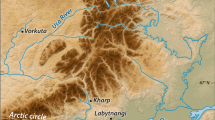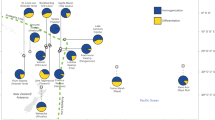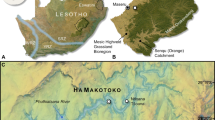Abstract
Pollen from deep-sea drilling sites on the Ninetyeast Ridge which reflects island floras that flourished in the Palaeocene and Oligocene, shows pronounced similarity to Australian and New Zealand early Tertiary floras. Although they were closer to southern landmasses during the Tertiary, these islands were truly oceanic, and their colonisation occurred through long-distance dispersal mechanisms.
This is a preview of subscription content, access via your institution
Access options
Subscribe to this journal
Receive 51 print issues and online access
$199.00 per year
only $3.90 per issue
Buy this article
- Purchase on Springer Link
- Instant access to full article PDF
Prices may be subject to local taxes which are calculated during checkout
Similar content being viewed by others
References
Geotimes, 17(6), 15–17 (1972).
Geotimes, 18(3), 16–19 (1973).
Harris, W. K., Init. Rep. Deep Sea Drilling Project, 22, 503–519 (1974).
Kemp, E. M., Init. Rep. Deep Sea Drilling Project, 26, 815–823 (1974).
Pimm, A. C., McGowran, B., and Gartner, S., Bull. geol. Soc. Am., 85, 1219–1224 (1974).
Sclater, J. G., and Fisher, R. L., Bull. geol. Soc. Am., 85, 683–702 (1974).
Luyendyk, B. P., and Davies, T. A., Init. Rep. Deep Sea Drilling Project, 26, 909–943 (1974).
McKenzie, D., and Sclater, J. G., Geophys. J. R. astr. Soc., 25, 437–528 (1971).
Pierce, J. W., Denham, C. R., and Luyendyk, B. P., Init. Rep. Deep Sea Drilling Project, 26, 517–527 (1974).
Davies, T. A., Luyendyk, B., et. al., Init. Rep. Deep Sea Drilling Project, 26, (1974).
McGowran, B., Init. Rep. Deep Sea Drilling Project, 22, 609–627 (1974).
von der Borch, C. C., Sclater, J. G., et. al., Init. Rep. Deep Sea Drilling Project, 22, (1974).
Watkins, N. D., Gunn, B. M., Nougier, J., and Baksi, A. K., Bull. geol. Soc. Am., 85, 201–212 (1974).
Raven, P. H., and Axelrod, D. I., Science, 176 1379–1386 (1972).
Seward, A. C., and Conway, V., Ann. Bot., 48, 715–741 (1934).
Cookson, I. C., Rep. B.A.N.Z. antarc. Res. Exped., A 2, 129–142 (1947).
Geotimes, 18(6) 19–24 (1973).
Skottsberg, C., Proc. R. Soc. B 152, (1960).
Preest, D. S., in Pacific Basin Biogeography (edit. by Gressit, J. L.), 415–424 (Bishop Museum, Honolulu, 1963).
Falla, R. A., Proc. R. Soc., B 152, 655–659 (1960).
Good, R., The Geography of the Flowering Plants, third ed. (Longmans, London, 1964).
Wace, N. M., Proc. R. Soc., B 152, 475–490 (1960).
Wace, N. M., in Biogeography and Ecology in Antarctica (edit. by van Oye, P., and van Mieghem, J.), 201–266 (W. Junk, The Hague, 1965).
Author information
Authors and Affiliations
Rights and permissions
About this article
Cite this article
Kemp, E., Harris, W. The vegetation of Tertiary islands on the Ninetyeast Ridge. Nature 258, 303–307 (1975). https://doi.org/10.1038/258303a0
Received:
Accepted:
Issue Date:
DOI: https://doi.org/10.1038/258303a0
This article is cited by
-
Genetic diversity, distributional barriers and rafting continents ? more thoughts on the evolution of mangroves
Hydrobiologia (1995)
-
Fossil pollen records of extant angiosperms
The Botanical Review (1981)
Comments
By submitting a comment you agree to abide by our Terms and Community Guidelines. If you find something abusive or that does not comply with our terms or guidelines please flag it as inappropriate.



